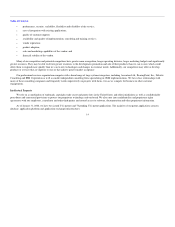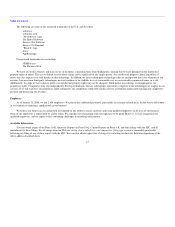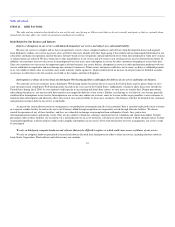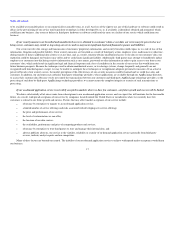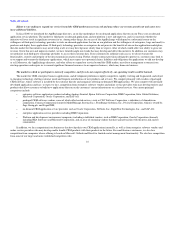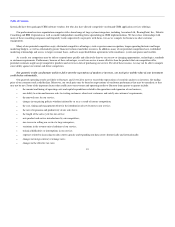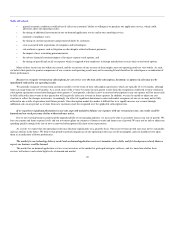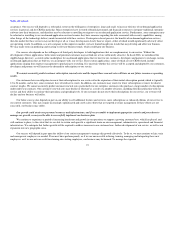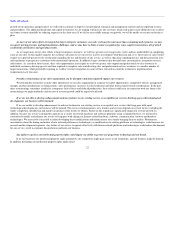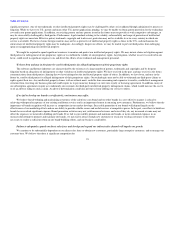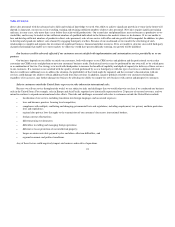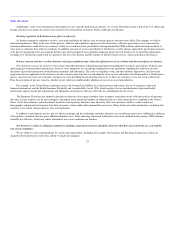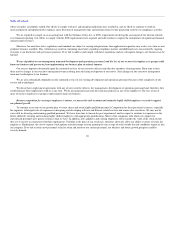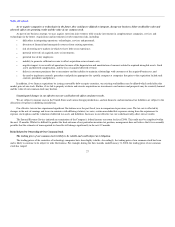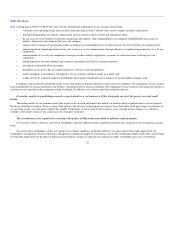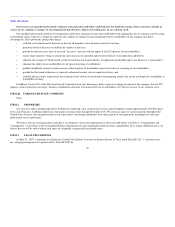Salesforce.com 2007 Annual Report Download - page 27
Download and view the complete annual report
Please find page 27 of the 2007 Salesforce.com annual report below. You can navigate through the pages in the report by either clicking on the pages listed below, or by using the keyword search tool below to find specific information within the annual report.
Table of Contents
direct sales personnel with the advanced sales skills and technical knowledge we need. Our ability to achieve significant growth in revenue in the future will
depend, in large part, on our success in recruiting, training and retaining sufficient numbers of direct sales personnel. New hires require significant training
and may, in some cases, take more than a year before they achieve full productivity. Our recent hires and planned hires may not become as productive as we
would like, and we may be unable to hire sufficient numbers of qualified individuals in the future in the markets where we do business. If we are unable to
hire and develop sufficient numbers of productive direct sales personnel, sales of our service will suffer and our growth will be impeded. In addition, we plan
to develop and expand our indirect sales channel by engaging third-party resellers. Because of our on-demand service model, the structuring of such
relationships is complex and requires the investment of significant business, financial and other resources. If we are unable to structure successful third-party
channel relationships that enable us to enter markets we otherwise would have greater difficulty entering, our growth will be inhibited.
Our business could be adversely affected if our customers are not satisfied with implementation and customization services provided by us or our
partners.
Our business depends on our ability to satisfy our customers, both with respect to our CRM service and platform and the professional services that
customize our CRM service and platform to meet our customers' business needs. Professional services may be performed by our own staff, or by a third party
or a combination of the two. Our strategy is to work with third parties to increase the breadth of capability and depth of capacity for delivery of these services
to our customers. If a customer is not satisfied with the quality of work performed by us or a third party or with the type of services or solutions delivered,
then we could incur additional costs to address the situation, the profitability of that work might be impaired, and the customer's dissatisfaction with our
services could damage our ability to obtain additional work from that customer. In addition, negative publicity related to our customer relationships,
regardless of its accuracy, may further damage our business by affecting our ability to compete for new business with current and prospective customers.
Sales to customers outside the United States expose us to risks inherent in international sales.
Because we sell our service throughout the world, we are subject to risks and challenges that we would otherwise not face if we conducted our business
only in the United States. For example, sales in Europe and Asia Pacific together have historically represented over 20 percent of our total revenues, and we
intend to continue to expand our international sales efforts. The risks and challenges associated with sales to customers outside the United States include:
• localization of our service, including translation into foreign languages and associated expenses;
• laws and business practices favoring local competitors;
• compliance with multiple, conflicting and changing governmental laws and regulations, including employment, tax, privacy and data protection
laws and regulations;
• regional data privacy laws that apply to the transmission of our customers' data across international borders;
• foreign currency fluctuations;
• different pricing environments;
• difficulties in staffing and managing foreign operations;
• different or lesser protection of our intellectual property;
• longer accounts receivable payment cycles and other collection difficulties; and
• regional economic and political conditions.
Any of these factors could negatively impact our business and results of operations.
24


